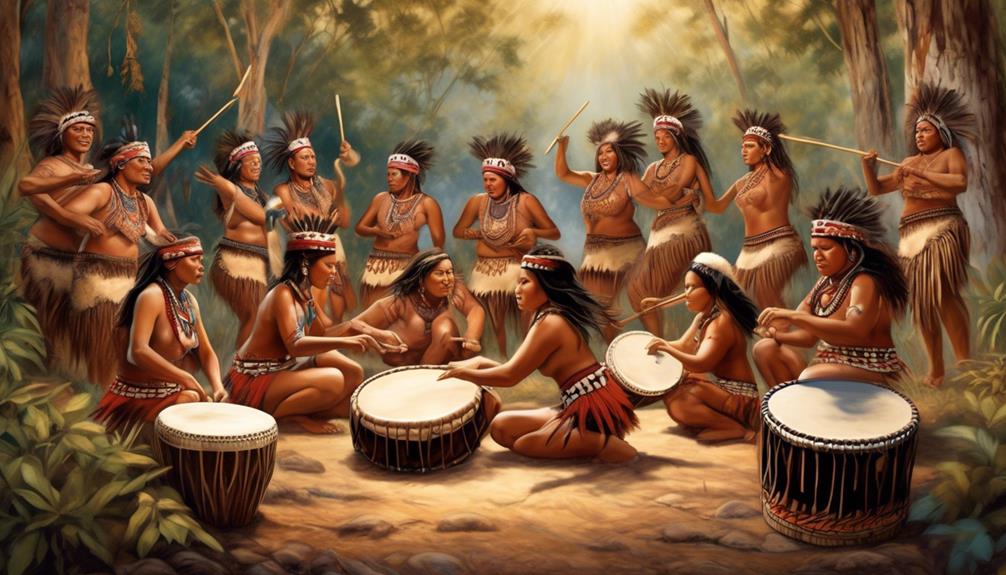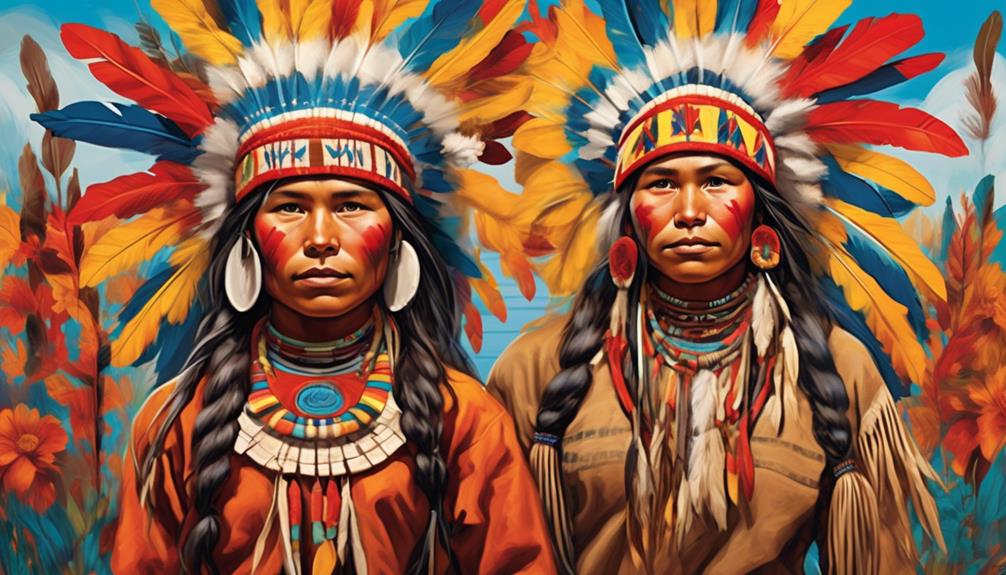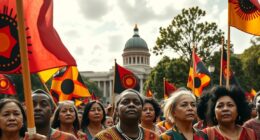Many times, we overlook the fact that African slaves weren’t the only ones forced into labor; indigenous peoples from the Americas were also coerced to work alongside African slaves. The interactions between European settlers and native populations led to the creation of the Encomienda system, impacting both communities for years to come.
The impact of this forced labor on indigenous communities, as well as the consequences it had on the overall dynamics of the Americas, is a complex and often overlooked aspect of history. As we explore this topic, we will uncover the interconnectedness of the experiences of indigenous peoples and African slaves, shedding light on a lesser-known aspect of their shared history.
Key Takeaways
- The Encomienda System and coerced labor involved both indigenous peoples and African slaves being forced to work for Europeans in the Americas.
- The exploitation of indigenous peoples and African slaves contributed to the economic wealth of European colonizers.
- The Encomienda System resulted in the displacement of indigenous communities from their ancestral lands and the suppression of their cultures.
- Resistance movements emerged to challenge the encomienda system and preserve indigenous languages, traditions, and beliefs.
The Encomienda System
The Encomienda System was a coercive labor system that granted Spanish colonizers control over Indigenous peoples and their labor in the Americas during the colonial period. It was established following the Spanish conquest and exploitation of the indigenous populations. The system was a form of labor exploitation, where Indigenous peoples were forced to work in mines, plantations, and other industries under brutal conditions for the benefit of the Spanish encomenderos. This exploitation led to widespread resistance movements as Indigenous communities fought against the oppressive system.
Despite facing immense challenges, Indigenous peoples organized various forms of resistance against the encomenderos and the Spanish colonial authorities. They engaged in rebellions, revolts, and other acts of defiance to resist the exploitation and mistreatment they endured. These resistance movements were crucial in challenging the unjust practices of the Encomienda System and advocating for the rights and freedoms of Indigenous peoples.
The Encomienda System, characterized by its severe exploitation and resistance movements, exemplifies the profound impact of Spanish colonialism on Indigenous communities in the Americas.
Indigenous Forced Labor

Indigenous peoples in the Americas were subjected to forced labor by the Spanish colonizers, leading to immense suffering and resistance. The economic exploitation of indigenous communities was pervasive, as they were coerced into working in mines, plantations, and other labor-intensive activities. This exploitation not only resulted in the decimation of indigenous populations but also led to the loss of their cultural autonomy and traditional ways of life. Despite these challenges, indigenous communities demonstrated remarkable cultural resistance, preserving their languages, traditions, and belief systems in the face of adversity.
| Cultural Resistance | Economic Exploitation |
|---|---|
| Preservation of indigenous languages, traditions, and beliefs | Coerced labor in mines and plantations |
| Resistance through art, music, and oral traditions | Loss of cultural autonomy and traditional ways of life |
| Revival of indigenous practices and ceremonies | Decimation of indigenous populations |
The resilience of indigenous peoples in the Americas in the wake of forced labor is a testament to their enduring strength and determination to uphold their cultural heritage despite the oppressive conditions imposed upon them.
African Slave Labor
During the colonial era, African slaves were forcibly brought to the Americas to labor in plantations, mines, and other grueling work environments, enduring unimaginable hardships and contributing significantly to the economic wealth of the European colonizers. The African exploitation for labor was a cornerstone of the transatlantic slave trade, which not only caused immense suffering but also left a lasting impact on the social and economic structures of the Americas. The labor exploitation of African slaves was systematic and brutal, as they were subjected to inhumane working conditions, physical abuse, and the denial of basic human rights.
The European colonizers sought to maximize their profits through the intensive labor of African slaves, extracting immense wealth from the toil and sweat of those they'd enslaved. The forced labor of African slaves not only enriched the European colonizers but also played a pivotal role in the development of the American economy, particularly in the production of cash crops such as sugar, cotton, and tobacco.
The legacy of African labor exploitation during the colonial era continues to shape the social and economic landscape of the Americas today.
Impact on Indigenous Communities

As colonial powers expanded their territories, indigenous communities across the Americas faced widespread displacement and exploitation. The impact on our communities was profound, leading to significant cultural assimilation and economic exploitation.
| Challenges Faced | Effects on Indigenous Communities | Actions Taken |
|---|---|---|
| Displacement | Many indigenous peoples were forcibly removed from their ancestral lands, disrupting their traditional ways of life and connection to the land. | Resistance movements emerged, seeking to protect and reclaim ancestral territories. |
| Cultural Assimilation | Indigenous cultures were suppressed, and traditional practices and languages were actively discouraged or banned, leading to a loss of cultural identity. | Efforts to preserve and revitalize indigenous languages and traditions were initiated, aiming to reclaim cultural heritage. |
| Economic Exploitation | Indigenous peoples were exploited for labor, often forced to work in harsh conditions for little to no compensation, further exacerbating poverty and inequality. | Community-led economic initiatives and advocacy for fair labor practices were undertaken to combat exploitation and promote economic independence. |
The impact of these challenges continues to resonate within indigenous communities, shaping our ongoing struggle for cultural resurgence and economic justice.
Consequences of Forced Labor
Facing displacement and economic exploitation has led to long-lasting consequences for our communities, including the perpetuation of forced labor and its detrimental effects on indigenous peoples and slaves. The exploitation of our labor has had profound economic impacts, as it has perpetuated cycles of poverty and hindered the development of our communities. Forced labor not only deprived us of our autonomy and freedom but also resulted in the cultural destruction of our traditional practices and knowledge systems. Our resistance against forced labor has been met with severe punishment, further perpetuating the cycle of exploitation.
The economic impact of forced labor has been devastating, as it has suppressed our ability to thrive and develop sustainable economies. The forced extraction of resources and labor from our communities has heavily contributed to the wealth and prosperity of the colonizers, perpetuating economic inequality and hindering our ability to achieve self-sufficiency.
Furthermore, the imposition of forced labor has led to the erosion of our cultural identity, as our traditional practices and knowledge systems have been systematically undermined and devalued. The consequences of forced labor continue to impact our communities to this day, emphasizing the need for recognition, restitution, and healing.
Frequently Asked Questions
How Did the Encomienda System Affect the Social and Cultural Practices of Indigenous Peoples?
The encomienda system profoundly impacted the traditions and cultural assimilation of indigenous peoples. It forced them to labor for Europeans, disrupting their social and cultural practices.
This system led to the erosion of indigenous traditions and the adoption of European customs. The forced labor and exploitation hindered the preservation of indigenous cultural practices and contributed to the assimilation of European ways of life.
What Were the Specific Tasks and Roles That Indigenous Peoples Were Forced to Perform for Europeans?
We were tasked with performing specific roles and tasks for the Europeans, impacting our cultural practices, social dynamics, and relationships.
The long-term effects were devastating, with severe economic and social consequences. It's ironic how our forced labor was meant to benefit the Europeans, but ultimately led to our oppression and exploitation.
The encomienda system tragically reshaped our way of life, forcing us into servitude and perpetuating a cycle of suffering.
How Did the Introduction of African Slave Labor Impact the Dynamics and Relationships Between Indigenous Peoples and Europeans?
The introduction of African slave labor significantly impacted the dynamics and relationships between indigenous peoples and Europeans. It transformed labor dynamics, leading to economic consequences and social effects.
This change affected traditional practices and cultural integration. The impact on relationships was profound, altering the power dynamics and creating new social hierarchies. The presence of African slaves alongside indigenous laborers reshaped the interactions and power structures between these groups and the Europeans.
What Long-Term Effects Did Forced Labor Have on Indigenous Communities, Including Their Population, Health, and Traditional Practices?
Forced labor had devastating long-term effects on indigenous communities. The population declined due to harsh conditions and disease, impacting traditional practices and health. Social and cultural changes occurred as communities struggled to cope.
Economic consequences were severe, disrupting the balance of indigenous societies. These repercussions still echo in our history, representing a dark chapter of exploitation and suffering.
What Were the Economic, Political, and Social Consequences of the Forced Labor System for Indigenous Peoples and Their Communities?
Forced labor inflicted economic hardships, political resistance, social displacement, and cultural assimilation on indigenous communities.
The system disrupted traditional economies, causing poverty and instability. It also sparked political resistance and uprisings against European oppressors.
Socially, it led to the displacement of indigenous peoples from their lands and communities. Culturally, it forced assimilation, eroding traditional practices and beliefs.
The consequences of forced labor were far-reaching and detrimental to indigenous societies.
Conclusion
In conclusion, the Encomienda system forced indigenous peoples and African slaves to work for Europeans, impacting their communities and livelihoods.
This exploitation of labor had devastating consequences, leading to the destruction of cultures and the loss of countless lives.
As the saying goes, "history repeats itself," reminding us of the dark legacy of forced labor and the importance of learning from the past to create a more just and equitable future.









